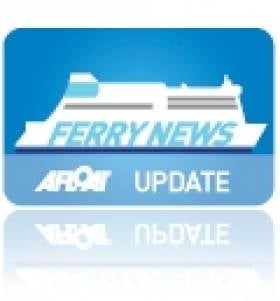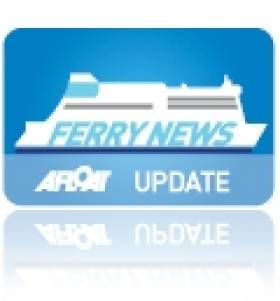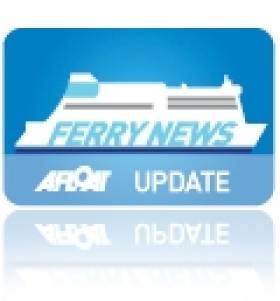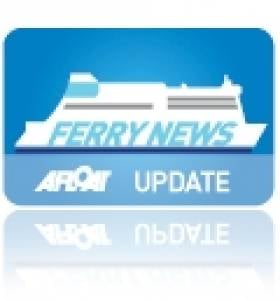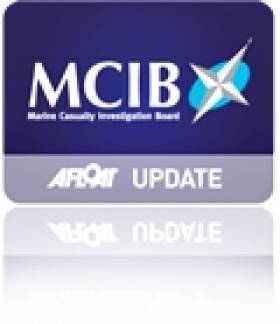Displaying items by tag: Ports and Shipping News
Passenger Rights to Extend to Ferry Sector
#PASSENGER RIGHTS - Ferry passengers taking routes running from Ireland will now enjoy the same rights as those who travel by air or rail, according to Breaking News.
Minister for Transport Leo Varadkar T.D. has announced that from 18 December, the National Transport Authority will assume responsibilities for enforcing passenger rights in the maritime sector.
The new rights are designed to protect against discrimination and ensure equality of access to maritime passenger services.
Irish Sea Central Corridor Ferry Operators Prepare For Seasonal Boost
#FERRY NEWS – Over the busy festive season and during the early New Year periods, Irish Sea 'central corridor' route ferry operators are preparing for an influx of passengers, writes Jehan Ashmore.
Stena Line's HSS Fastcraft will return on the Dun Laoghaire-Holyhead route for the festive season with the following sailing schedule: 20-23 December, 27-30 December and between 2-5 January 2013.
The route is served by the HSS Stena Explorer fastcraft with a crossing time of 1 hour 20 minutes. For further information about the service, click here.
In addition Stena Line operate sailings on the Dublin Port-Holyhead route, which is served by two conventional superferries, Stena Adventurer and Stena Nordica on the 3 hours 15 minute service. For further details click here.
Irish Ferries Dublin Port-Holyhead route is served by cruise ferry Ulysses and fast ferry Jonathan Swift, though for the festive period the cruise ferry, Isle of Inishmore will be introduced to provide an extra sailing in each direction on the following dates: 22, 23 and 27 December and 2 and 3 January 2013.
Passage times on the route for the cruise-ferries take 3 hours 15 minutes and the fast ferry crossing is 1 hour 49 minutes. For more information and sailing times click here.
Also running service on the central corridor is P&O Ferries Dublin Port-Liverpool route which is served by a trio of ro-pax ferries, European Endeavour and sisters Norbank and Norbay.
They operate to a crossing time of between 7 hours 30 minutes and 8 hours 5 minutes, which varies subject to sailing times. On this route, the service does not cater for foot passengers. Details of this service can be found on their website here.
Irish Ferries to Boost Dublin Route Capacity Over Festive Season
#FERRY NEWS – In an unprecedented move Irish Ferries are to operate three vessels on the Dublin-Holyhead route in the run-up to the busy festive and New Year periods, writes Jehan Ashmore.
Irish Ferries will transfer the cruiseferry Isle of Inishmore (1997/34,031grt) onto the popular central Irish Sea route linking the capital with North Wales. This will enable additional capacity of 2,200 passengers and more than 800 vehicles at a time when rivals are cutting back winter services.
The Dublin route is already served by the 'flagship' Ulysses, one of the largest car-ferries in the world and the twin-hulled catamaran Jonathan Swift which has a crossing time of 1 hour 49 minutes. The high-speed ferry which is marketed as the 'Dublin' Swift is the only fast ferry serving on the Irish Sea to operate on a year-round basis.
Isle of Inishmore is scheduled to run the additional Dublin-Holyead sailings on the following dates: 22, 23 and 27 December 2012, and on 2 and 3 January 2013. As such the Isle of Inishmore will provide an extra sailing in each direction on the central corridor route.
Head of Passenger Sales at Irish Ferries Dermot Merrigan said "So many people in the UK have Irish roots that Christmas and New Year are some of our busiest sailings".
"In previous years, bad weather has hit airports hard, sending thousands of extra passengers our way at the last minute. We're making plans now, so that whatever happens, travellers can rely on Irish Ferries to get them home in time for Christmas."
With the Isle of Inishmore's additional sailings, Irish Ferries will have the capacity to carry 6,360 passengers and 3,820 vehicles between the UK and Ireland on each of those five key dates.
On those dates, the Oscar Wilde, which usually serves between Ireland and France, will replace the Isle of Inishmore on the Rosslare–Pembroke Dock route.
What’s In a Name: Sten A. Ferry- 50 Years in Service
#STENA 50 YEARS- This year marks the 50th anniversary of Stena Line, the household name of the Swedish owned ferry giant. The company took the trading name from founder Sten A. Ollsen who began originally in 1939 with a small chartered cargoship named Dan, after his son, who currently holds several chairman positions throughout the Stena sphere of operations, writes Jehan Ashmore.
The first foray into a passenger (only) ferry was in 1962 with chartered tonnage on a route from Stenpiren in Gothenburg to Skagen in Denmark. The vessel the MS Østersøen was packed with happy, Christmas-shopping Gothenburgers looking for alcohol, tobacco and food at bargain prices! It seemed as if a new phenomenon had started in Gothenburg.
Only two years later the company had announced its first custom-built car ferry, Stena Germanica, which was to serve on the night-service from Gothenburg to Kiel. As the company continued to become successful, more routes were developed and new or chartered tonnage was added.
Among the new vessels ordered during the 1970's was Stena Scandinavia, one of a quartet of well proportioned and handsome looking car-ferries built for Stena's Scandinavian service. She served the Swedish-German route for five years until sold in 1978 to Irish Continental Line (ICL) to become Saint Killian (scroll down) on Irish-French routes.
In 1981/2 she was lengthened and renamed Saint Killian II, a name she retained also with her Irish Ferries career. She was sold in 1998 to Greeks interests, then resold with the vessel chartered to Algérie Ferries. There were also periods of lay-up until she was scrapped in 2007 in Alang, India.
Over the past four decades the Stena Line group has expanded considerably and is one of the world's largest ferry operators with an extensive ferry (and freight) network of 19 routes in Scandinavia and radiating from ports in the UK. In total the routes connect eight countries, served by 35 vessels, and overall the company employ 5,700 people.
Stena Line are running a 50 years with memories! campaign, where prizes are being given away including a year's free travel with the operator, and 5 iPhones, for details click HERE.
‘Open Day’ Maritime Event at NMCI
#NMCI OPEN DAY – The annual 'Open Day' at the National Maritime College of Ireland (NMCI) in Ringaskiddy, Co. Cork, is to be held on Tuesday, 23rd October from 10:00 - 3:00 pm.
The maritime event will showcase the following courses:
B.Sc in Nautical Science
B.Eng in Marine & Plant Engineering
B.Eng Marine Electrotechnology
Higher Certificate in Science in Nautical Studies
For group bookings please email: [email protected] For enquiries contact NMCI on Tel: (021) 497 060 and www.nmci.ie
Stena Line Freight Wins Award
#LOGISTIC AWARDS – Stena Line Freight collected the Irish Sea Shipping Line of the Year Award at the Export & Freight Transport & Logistics Awards 2012.
The award was presented to Stena Line's Irish Sea freight commercial manager Frank Nieuwenhuys, at a ceremony held this week at the Ramada Hotel in Belfast.
Among the winners was Carna Transport based in Monaghan, which won in the best European Haulier category while NMC Haulage of Dungannon, Co. Tyrone picked up Haulier of the Year.
Multi-Cat Joins Fleet at Island Shipping
#PORTS & SHIPPING -Island Kestrel (2009/90grt) a 22m Multi-Cat, is the latest acquisition for Island Shipping, the Wicklow based marine engineering, plant and consultancy company, writes Jehan Ashmore.
The versatile shallow draft twin –screw vessel is of the Eurocarrier 2209 design built by Neptune Marine Service in The Netherlands. The vessel is equipped with powerful winches, a deck crane and fuel and water transfer systems.
Island Kestral is classified by Bureau Veritas as a I HULL MACH Special Service Multi-Purpose Vessel. This designation allows the vessel to perform an impressive and wide-range of tasks: towage (15 tonnes bollard),salvage, barge, and anchor handling, dredge support, fuel and fresh water supply; survey, sampling and dive support.
She is to be deployed to operate in the charter market in offshore construction projects, both in the renewables and marine civil sectors.
Ports & Shipping Review: EU Ports Conference, Irish Cargoship Strikes Rock, Cruise Sector, Lifeline for WWI Warship, Lightship Scrapped and more…
#PORTS & SHIPPING REVIEW - Over the last fortnight Jehan Ashmore has reported from the shipping scene, where the European Commission hosted a major ports conference on the EU policy framework for ports.
Irish Ferries won 'Best Ferry Operator' in an award held in Birmingham, which was presented by Group Leisure, a leading British travel trade publication.
A brand new Irish flagged cargoship, Huelin Dispatch (2012/2,545grt) struck a rock while on its maiden voyage from Southampton to the Channel Islands. No crew were injured and the vessel was re-floated and then proceeded to dry-dock in Falmouth.
Large cruiseship operators could be a source of funding for the proposed redevelopment of Galway Port, a Joint Oireachtas Committee on Transport and Communications has been told.
Next year cruise passengers will be able for the first time to travel directly from Ireland to Norway on a major cruiseship from Cobh operated by Royal Caribbean International.
The 98 year-old HMS Caroline, berthed in Belfast, is to be given a lifeline, after the Stormont Assembly is to allocate £100,000 for restoration work on the famous World War I warship.
An industrial dispute over crew salaries and conditions at Brittany Ferries which ran for ten days ended earlier this week and where sailings on the Cork-Roscoff route returned to service yesterday.
The former headquarters of the Commissioners for Irish Lights in Dublin 2 is for sale at €2.85 million on the instructions of Nama, which is 89% drop on the €26 m paid for the block in 2006 by Pembroke Partnership.
A report by the MCIB was published into the grounding of Arklow Raider (2007/2,999grt) at the mouth of the River Boyne in 2010, nobody was injured and no pollution occurred.
One of the last surviving Irish lightships, ALF Skua which was automated in the early 1980's, finally ended her days as work on scrapping took place on the banks of the River Avoca in Arklow.
Today marks the final day of the Open House Dublin weekend, which was organised is to make architecture more accessible to the public and free of charge. Among the events today are guided tours (first come, first served basis) of the current headquarters of the Commissioners of Irish Lights and the National Maritime Museum of Ireland also located in Dun Laoghaire. For details visit www.openhousedublin.com
Report on Cargoship Grounding at the Boyne Bar
#MCIB REPORT– A report investigating the grounding of the Arklow Raider (2007/2,999grt) at the mouth of the River Boyne in 2010, was published yesterday by the Marine Casualty Investigation Board (MCIB).
The 89m general cargoship managed by Arklow Shipping Ltd had docked in Drogheda on 10th November to discharge a full cargo and this was followed by loading cement in bulk.
The Dutch built vessel remained in the Co. Louth port until she departed on the evening tide of the 16th November, however as the vessel passed the bar at the entrance to the River Boyne, it took to the ground and became fast.
The vessel was successfully re-floated on 19th November. Once afloat, checks were made and the vessel was towed to Dublin. At Dublin, the cargo was transhipped to another vessel and the vessel entered dry dock in the port for repairs to the hull and steering gear. Nobody was injured and no pollution occurred.
To read the report in full, copies in PDF format are available to download from the MCIB website HERE.
Brittany Ferries Sailings Resume Service
#FERRY NEWS- Brittany Ferries are to resume sailings today, following the end of an industrial dispute as previously reported on Afloat.ie, which was carried out by employees that led to services halted between UK, France, Ireland and Spain.
The Breton ferry company was forced to suspend services for 10 days after strikes erupted and employees fought to disrupt the operator which sought cuts in costs by reducing salaries and the frequency of crossings.
The Irish service, operated by the Pont-Aven on the weekend only round-trip route from Roscoff to Cork, is to depart the French port this Friday 5th October, at 21.15hrs. The return sailing departs Cork (Ringaskiddy) on Saturday 6th October at 16.00hrs.
All English Channel routes are to resume today though the company had to cancel tomorrow's 11.00hrs sailing from Portsmouth to Santander as the ship is out of position.


























